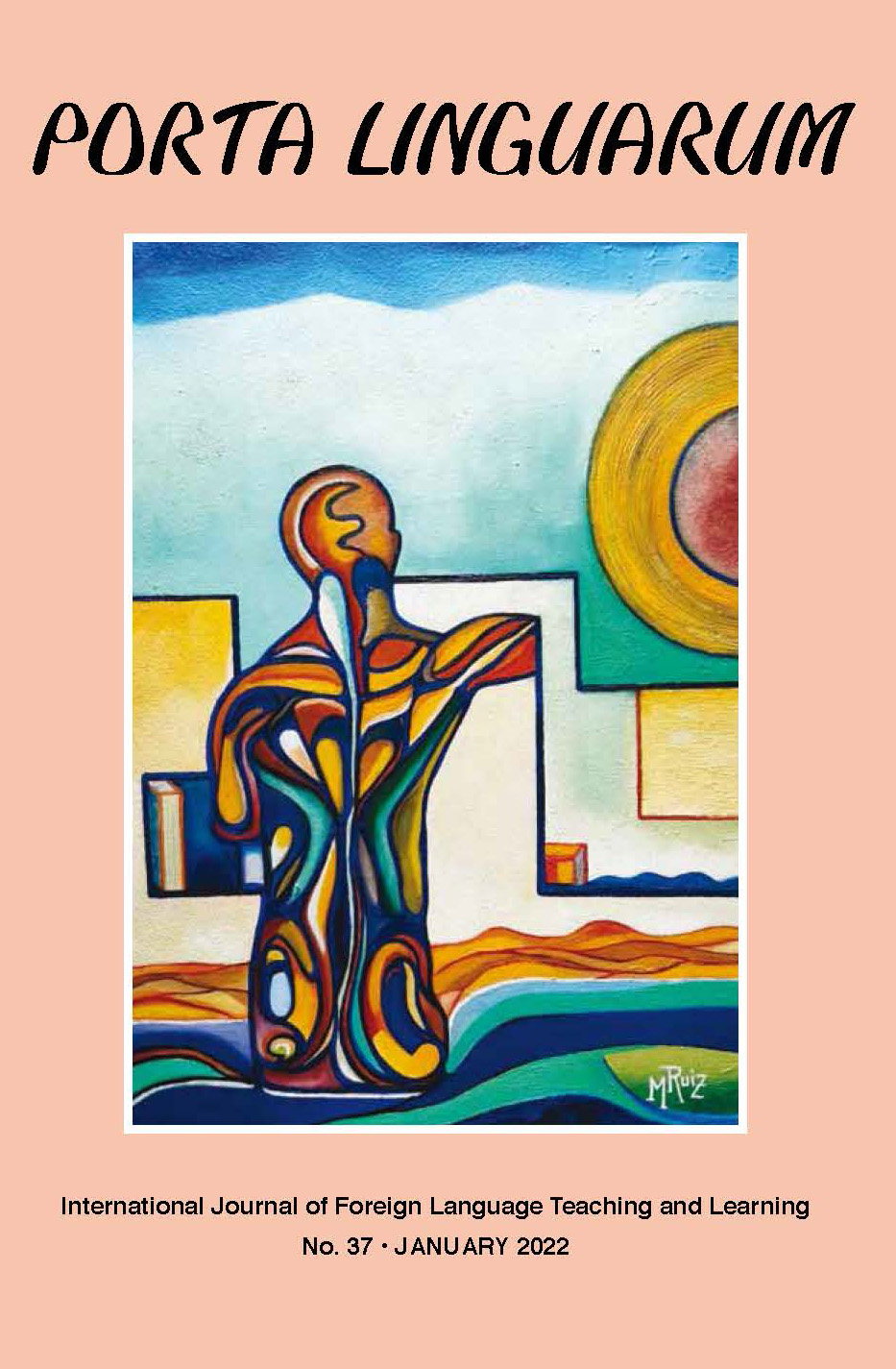Usando el método de “los seis sombreros para pensar” para aumentar el conocimiento intercultural: Estudio pre-experimental
DOI:
https://doi.org/10.30827/portalin.vi37.20771Palabras clave:
conocimiento intercultural, comunicación intercultural, pensamiento paralelo, seis sombreros para pensar, ELTResumen
Debido al aumento de la movilidad de la población mundial impulsada por la tecnología, las personas de todo el mundo interactúan entre sí más que nunca. Esta globalización revela la necesidad por el conocimiento intercultural. Este estudio tiene como objetivo aumentar el conocimiento intercultural entre los estudiantes de inglés como lengua extranjera que tienen entre 12 y 13 años mediante el uso del modelo "Seis sombreros para pensar" con varias modificaciones y presentar una alternativa al modelo original propuesto por Edward De Bono. Se utilizó un método de muestreo intencional para seleccionar a los participantes que se supone que tienen menos conocimiento intercultural como resultado de la prueba previa. Para lograr una observación cercana y profunda, se eligió un diseño grupal de preprueba-posprueba. Para rastrear las diferencias y similitudes que ocurrieron en los comportamientos de los participantes durante el tratamiento, se recopilaron y analizaron datos cualitativos con el uso del método de comparación constante. Los resultados mostraron que la versión modificada del modelo "Seis sombreros para pensar" muestra efectos en las actitudes de los participantes. El enfoque de los participantes con respecto a los problemas de base cultural cambió sus juicios personales al cuestionamiento y entendimiento.
Descargas
Citas
Poems in EFL Classrooms. In Social Sciences, Humanities and Economics Conference
(SoSHEC 2017). Atlantis Press.
Alexiou, A., Mysirlaki, S., Souki, A., Koroneuo, L., Geomelou, A., Chatziiliou, A., &
Paraskeva, F. (2015). The Development of Creative Thinking Through Six Thinking Hats
and Web 2.0 Technologies. The International Journal of Technologies in Learning, 22(2),
15-28.
Ayaz Can, H. (2005). Altı şapkalı düşünme tekniğinin ilköğretim altıncı sınıf öğrencilerinin
sosyal bilgiler dersindeki akademik başarısına etkisi [Unpublished master’s thesis].
Fırat Üniversitesi.
Bezir, Ç. & Baran, B. (2015). Foreign Language Teaching Through the Six Thinking Hats
Technique in Second Life. Education and Science, 39(171), 392-406.
Brown, H. D. (1991). TESOL at twenty-five: What are the issues? TESOL Quarterly, 25(2)
,245-260. https://doi.org/10.2307/3587462
Chen, G. M., & Starosta, W.J. (1998). A review of the concept of intercultural awareness.
Human Communication, 2(1), 27-54.
Cioffi, J. (2017). Collaborative care: Using six thinking hats for decision making.
International Journal of Nursing Practice, 23(6), e12593.
https://doi.org/10.1111/ijn.12593
De Bono, E. (1985). Six Thinking Hats: An essential approach to business management.
Little, Brown, & Company, New York, USA.
De Bono, E. (1999). Six thinking hats (Vol. 192). New York: Back Bay Books.
Dey, I. (1993). Creating categories. Qualitative data analysis (pp. 94-112). London:
Routledge.
Dimitrov, M. D. & Rumrill, D. P. (2003). Pretest-posttest designs and measurement of
change. Speaking of Research, 20(2), 159-165.
Erişen, Y. & Katmer-Bayraklı, V. (2016). Six Hat Thinking Technique in Program
Evaluation: The Evaluation of the Quality of Mathematics Teacher Training Program in
Turkey. International Online Journal of Educational Sciences, 8(4), 31-45.
Geissler, G. L., Edison, S. W., & Wayland, J. P. (2012). Improving Students' Critical
Thinking, Creativity, and Communication Skills. Journal of Instructional Pedagogies, 8.
Goetz, J. P., & LeCompte, M. D. (1981). Ethnographic research and the problem of data
reduction. Anthropology and Education Quarterly, 12(1), 51-70.
https://doi.org/10.1525/aeq.1981.12.1.05x1283i
Halx, M., & Reybold, L. (2006). A Pedagogy of Force: Faculty Perspectives of Critical
Thinking Capacity in Undergraduate Students. The Journal of General Education, 54(4),
293-315.
Janesick, V. J. (1994). The dance of qualitative research design: Metaphor, methodology, and
meaning. In N. K. Denzin, & Y. S. Lincoln (Eds.), Handbook of qualitative research (pp.
209-219). Thousand Oaks, CA: Sage.
Kiss, T., & Weninger, C. (2017). Cultural learning in the EFL classroom: The role of visuals.
ELT Journal, 71(2), 186-196. https://doi.org/10.1093/elt/ccw072
Kusumaningputri, R., & Widodo, H. (2017). Promoting Indonesian university students'
critical intercultural awareness in tertiary EAL classrooms: The use of digital photograph-
mediated intercultural tasks. System, 72, 49-61.
https://doi.org/10.1016/j.system.2017.10.003
Orhan, S., & Kırbaş, A.,& Topaş, Y. (2012). Six Thinking Hats Technique Supported Visuals
Effects of Students’ Speaking Skills Develop. International Periodical for the Languages,
Literature and History of Turkish and Turkic. 7(3), 1893-1909.
Patton, M. Q. (1990). Qualitative evaluation and research methods (2nd ed.). Newbury Park,
CA: Sage.
Payette, P., & Barnes, B. (2017). Teaching for Critical Thinking: Edward de Bono's Six
Thinking Hats. The National Teaching & Learning Forum, 26(3), 8-10.
https://doi.org/10.1002/ntlf.30110
PM Ribeiro, S. (2016). Developing intercultural awareness using digital storytelling.
Language and Intercultural Communication, 16(1), 69-82.
https://doi.org/10.1080/14708477.2015.1113752
Ruben, B. D. (1976). Assessing communication competency for intercultural adaptation.
Group & Organization Studies, 1(3), 334 354.
https://doi.org/10.1177/105960117600100308
Ruben, B. D., & Kealey, D. J. (1979). Behavioral assessment of communication competency
and the prediction of cross-cultural adaptation. International Journal of Intercultural
Relations, 3(1), 15-47. https://doi.org/10.1016/0147-1767(79)90045-2
Tanghe, S. (2016). Promoting critical racial awareness in teacher education in Korea:
Reflections on a racial discrimination simulation activity. Asia Pacific Education
Review, 17(2), 203-215. https://doi.org/10.1007/s12564-016-9424-y
Tomlinson, B. (2019). Developing Intercultural Awareness through reflected experience of
films and other visual media. Using Film and Media in the Language Classroom:
Reflections on Research-led Teaching, 19-29.
Triandis, H.C. (1977). Theoretical framework for evaluation of cross-cultural training
effectiveness. International Journal of Intercultural Relations, 1, 195-213.
Vourdanou, K. (2017). Integrating the CLIL approach: Literature and Wikis in the Greek
EFL Classroom as a Means of Promoting Intercultural Awareness. Research Papers in
Language Teaching and Learning, 8(2), 103-119.



















